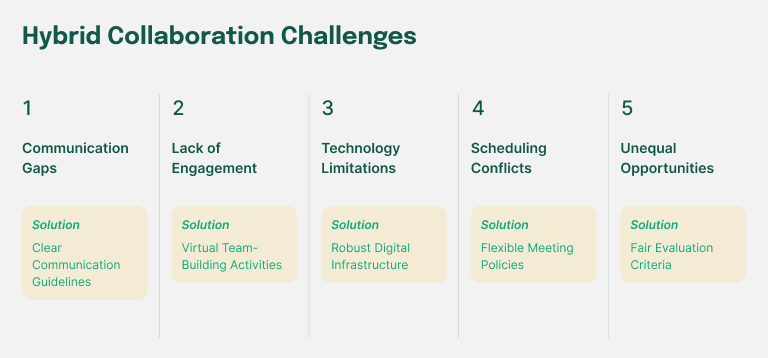project management · Apr 14, 2025
10 Strategies to Make Hybrid Collaboration Effective in Your Team

Introduction
Hybrid collaboration has rapidly transformed how teams work, blending remote and in-office interactions to create a flexible and dynamic work environment. According to a recent study, over 74% of businesses have adopted hybrid work models, with industries like tech, finance, and consulting leading the trend. While this approach enhances flexibility and global talent access, it also introduces unique challenges that require strategic solutions.
Understanding Hybrid Collaboration
Hybrid collaboration refers to a working model where some team members work remotely while others are in the office, all staying connected through digital tools . This approach allows companies to maintain operational efficiency while accommodating employees' preferences and geographic constraints. To make hybrid collaboration truly work, you need more than just the right tools—you need clear communication, a strong sense of accountability, and a team culture that makes everyone feel included.
4 Types of Hybrid Collaboration
1. Synchronous Hybrid Collaboration
This model of hybrid collaboration enables real-time interactions between remote and on-site team members through video conferencing, instant messaging, and live collaborative tools such as virtual whiteboards. It is ideal for collaborative brainstorming sessions, daily stand-ups, and decision-making meetings that require immediate feedback. However, it requires careful scheduling—especially when team members are spread across different time zones. Companies using this model should invest in reliable communication tools and establish meeting best practices to keep discussions focused and efficient.
2. Asynchronous Hybrid Collaboration
Asynchronous hybrid collaboration allows team members to contribute independently across different time zones and schedules. This model relies heavily on detailed documentation, project management platforms, and accessible content such as recorded meetings or detailed email threads.
Asynchronous collaboration is highly effective for global teams spread across multiple time zones, as it supports continuous workflow without the constraints of real-time scheduling . This model enhances deep work and reduces meeting fatigue but requires clear guidelines on response expectations, version control in shared documents, and regular check-ins to prevent delays or miscommunication.
3. Task-Based Hybrid Collaboration
Task-based hybrid collaboration divides responsibilities according to the strategic benefits of either the remote or on-site settings.For example, hands-on tasks like product testing, physical prototyping, or client-facing roles are handled on-site, while documentation, coding, data analysis, or marketing content creation can be done remotely.
This type of hybrid collaboration optimizes productivity by leveraging the strengths of both work environments. However, workplace challenges can arise if dependencies between remote and in-office tasks are not well-managed. In this case, tools like digital kanban boards and integrated project management software can help maintain transparency and streamline workflows.
4. Rotational Hybrid Collaboration
In this model, employees alternate between remote and in-office work on scheduled days, ensuring a mix of in-person collaboration and remote flexibility. Organizations can designate specific days for in-office work, dedicated to creative collaboration, team-building, and hands-on activities, while remote days are reserved for tasks that require concentration and minimal distractions.
However, rotational schedules can lead to inconsistencies in communication if not properly managed. To make this model effective, teams should establish structured in-office collaboration days for brainstorming, training, or team-building while reserving remote days for deep work and independent tasks.
5 Hybrid Collaboration Challenges

1. Communication Gaps
With team members distributed across different locations, misunderstandings can arise due to limited face-to-face interactions. Over-reliance on text-based communication can also lead to misinterpretations. Without real-time cues such as tone and body language, messages can be taken out of context, leading to friction. In written communication, using an AI humanizer can help make text sound more natural and relatable, reducing misunderstandings in hybrid teams. Teams should establish clear guidelines for communication, such as when to use video calls versus written updates, and encourage clarity in messaging by using structured formats or bullet points to convey important information.
2. Lack of Engagement
Remote employees may feel isolated or disconnected from in-office activities, leading to reduced engagement and motivation. Without proactive inclusion strategies, hybrid collaboration can result in siloed teams. To combat this, companies should implement virtual team-building exercises, regular one-on-one check-ins, and hybrid-friendly social events. Encouraging informal interactions through chat groups or virtual coffee breaks can help build stronger relationships and reduce feelings of isolation.
3. Technology Limitations
An ineffective digital infrastructure can disrupt hybrid collaboration. Slow internet speeds, incompatible software, or lack of proper collaborative tools can hinder workflow and create frustration among team members. Organizations must ensure that all employees, regardless of location, have access to the necessary tools and IT support. Standardizing software across teams, providing stipends for home office upgrades, and conducting regular tech audits can help prevent disruptions and ensure smooth operations.
4. Scheduling Conflicts
Coordinating meetings across different time zones and work schedules can be challenging. Without proper planning, some team members may feel excluded from important discussions or decision-making processes. To address this, companies should adopt flexible meeting policies, rotate meeting times to accommodate different regions, and provide recorded versions of meetings for asynchronous review. Additionally, leveraging shared calendars with time zone visibility and automated scheduling assistants can help teams find the best time for collaboration without excessive back-and-forth communication.
5. Unequal Opportunities
Hybrid collaboration can sometimes create biases where on-site employees have more visibility and career advancement opportunities compared to their remote counterparts. This can affect team morale and retention. To ensure fairness, companies should implement transparent evaluation criteria based on performance rather than physical presence. Encouraging managers to provide equal mentorship opportunities, recognize remote contributions, and promote a culture of inclusion can help bridge this gap.
10 Strategies to Make Hybrid Collaboration Effective
1. Establish Clear Communication Protocols
Developing structured communication guidelines ensures clarity and prevents misunderstandings that can arise from dispersed teams. Teams should define which tools to use for specific types of communication—such as email for formal updates, instant messaging for quick questions, and video calls for discussions requiring deep engagement. Additionally, setting expectations for response times, defining meeting etiquettes, and establishing dedicated channels for critical updates can help balance synchronous and asynchronous hybrid collaboration effectively.
2. Utilize Hybrid Collaboration Tools
Investing in robust digital tools is essential for seamless hybrid collaboration. Project management platforms like Quire enable real-time task tracking, collaboration boards, and document sharing. Video conferencing tools, cloud storage solutions, and workflow automation software can further enhance productivity. Organizations should also provide training on these tools to ensure teams use them efficiently and integrate them into daily workflows to boost productivity and collaboration across different locations.
3. Encourage Equal Participation
Ensuring that all team members—both remote and on-site—have an equal voice is crucial for maintaining balance. Organizations can implement a “remote-first” meeting approach, where all participants join via video conferencing to create an even playing field. Assigning rotating facilitators for virtual discussions, encouraging contributions through structured agendas, and leveraging collaborative digital whiteboards can boost engagement and inclusivity.
4. Schedule Inclusive Meetings
Creating inclusive meeting schedules is vital in a hybrid environment. Utilize shared team calendars that display all time zones to ensure transparency and reduce scheduling conflicts. Rotating meeting times can help distribute the inconvenience of off-hour meetings equitably among team members across different regions. By recording meetings and providing detailed summaries, you guarantee that those unable to attend live sessions—whether due to time zone differences or other commitments—can still stay informed and contribute asynchronously. This approach not only ensures that every voice is heard but also maintains the continuity of collaboration by providing structured, accessible meeting materials.
5. Foster a Strong Hybrid Work Culture
Building a robust hybrid work culture is essential for bridging the gap between remote and in-office teams. Regular informal interactions, such as virtual coffee breaks and online team-building activities, create opportunities for personal connection and help reduce the sense of isolation often felt by remote employees. A strong collaborative culture also involves recognizing achievements and celebrating contributions equally, regardless of location, which reinforces the value of every team member. By maintaining consistent check-ins and encouraging open communication, organizations can nurture an environment of mutual respect and inclusivity, ultimately fostering a more engaged and cohesive team.
6. Implement Outcome-Based Performance Measurement
Shifting from a traditional hours-worked model to an outcome-based performance measurement approach allows organizations to evaluate productivity based on results rather than physical presence. Clearly defined goals and key performance indicators (KPIs), along with regular progress reviews, help ensure that every team member understands expectations and remains accountable for deliverables. This results-oriented framework not only drives efficiency and innovation by focusing on tangible outputs but also supports flexibility by empowering employees to work in ways that suit their personal circumstances while still contributing to overall team success.
7. Address Security and Data Management
For hybrid teams, robust security and data management practices are critical to protecting company information and maintaining trust. Implementing cybersecurity measures such as encrypted communications, two-factor authentication, and strict data-sharing policies minimizes the risk of breaches and ensures compliance with data protection regulations. By standardizing security protocols across both remote and in-office environments, organizations create a safe digital workspace that supports seamless collaboration. This proactive approach to security not only safeguards sensitive data but also reassures team members that they can work confidently, regardless of their location.
8. Promote Leadership Training for Hybrid Teams
Equipping managers with the right skills is critical to steering hybrid teams effectively. Leadership training tailored for hybrid environments should cover digital communication techniques, conflict resolution in virtual settings, and strategies for fostering team cohesion remotely. For example, leadership workshops can include role-playing exercises that simulate common remote challenges, helping managers practice resolving conflicts when tone and context may be misinterpreted online. Furthermore, mentoring programs that pair experienced hybrid leaders with new managers can create an environment where best practices are shared, ensuring that leadership adapts continuously to evolving team needs.
9. Optimize Office Space for Hybrid Work
Even in a hybrid model, the physical workspace remains essential for fostering collaboration and innovation. Redesigning office spaces to support flexible working arrangements can significantly enhance productivity. This might include creating modular workstations that can be reconfigured based on project needs, installing high-quality video conferencing equipment in meeting rooms to bridge the gap between remote and in-office teams, and setting up quiet zones for focused work. Additionally, adopting a hot-desking model or scheduling dedicated collaboration days can help maximize the efficient use of space while ensuring that employees feel a sense of belonging when they are on-site.
10. Gather Continuous Feedback
An effective hybrid collaboration strategy is never static—it requires constant refinement based on employee input. Regularly gathering feedback through surveys, one-on-one check-ins, and team retrospectives provides insights into what is working and what needs improvement. For instance, using pulse surveys can help track team sentiment in real time, allowing leaders to address issues promptly before they escalate. Furthermore, establishing an open-door policy where employees feel safe sharing their experiences can lead to actionable insights. This iterative approach ensures that the collaboration model evolves with the team’s needs and external changes, driving long-term success.
Successful Hybrid Collaboration Example(s)
Microsoft’s Hybrid Work Approach
Microsoft has successfully implemented hybrid collaboration by providing employees with flexible work arrangements, equipping teams with Microsoft Teams and cloud-based solutions, and emphasizing outcome-based performance. Their approach demonstrates how structured flexibility and the right tools can create an effective hybrid work environment.
Dropbox’s Virtual-First Strategy
Dropbox transitioned to a virtual-first model, allowing employees to work remotely while using office spaces for intentional collaboration. By investing in digital collaboration tools and redefining workplace culture, Dropbox has maintained high levels of productivity and employee satisfaction.
Quire Helps Promote Hybrid Collaboration in Your Team
Quire is a powerful project management tool designed to enhance hybrid collaboration. With features such as task delegation, real-time updates, and seamless integrations, Quire ensures that hybrid teams stay organized and aligned. Whether managing projects asynchronously or conducting live brainstorming sessions, Quire provides the flexibility and structure needed for hybrid team collaboration.
By implementing effective strategies and utilizing the right hybrid collaboration tools, teams can overcome challenges and maximize productivity in a hybrid work environment. Hybrid collaboration is the future of work—embracing it strategically will give teams a competitive edge in today’s dynamic business landscape.

